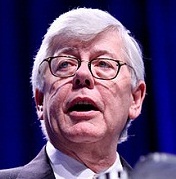You are here
Recognizing the plights and frustrations of the Republican voter
Democratic leaders talk about the working- and middle-classes, voters they neither understand nor respect
ANALYSIS/OPINION:
Since the 1960s, the two major U.S. political parties have been trading constituencies. The Democratic Party of Kennedy, Roosevelt and Truman focused in a quasi-populist manner on working- and middle-class Whites and on minority voters who became a key part of the party’s coalition after World War II.
The party’s candidates talked about freedom, bread and butter issues, and patriotism. Their voters worked the nation’s mills and factories, fought our wars, attended church regularly and lived in vibrant urban, and the new suburban neighborhoods that sprung up in the ’50s and ’60s.
The Republicans were businessmen, farmers, Wall Streeters, and a White Anglo-Saxon Protestant establishment that had dominated the politics and the economy of the nation in an earlier age. Their patriotism was subdued but just as strong. They tended to be more highly educated and as a group earned more. Republicans tolerated the New Deal and a more activist government than their parents because they had to but talked more about balanced budgets and the economy in ways that resonated more with their voters than with those who voted for Democrats.
Prior to the Goldwater campaign of 1964, the gate keepers of the GOP were to be found in corporate board rooms, banks and on country club golf courses. After Goldwater, the country clubbers were replaced by volunteer housewives and the men and women who ran the corner cleaners and other small businesses.
By 1969, Republican President Nixon and Vice President Spiro Agnew were appealing to many of their voters as a “silent majority.” Pollster Arthur Finkelstein was urging Republican candidates to appeal to voters he described as “peripheral urban ethnics.” These were mainly Catholic Irish, Italian and Polish men and women in and around urban centers like Chicago, New York City and Pittsburgh; the sons and daughters of immigrants who had been dependable Democratic voters but who were drifting away from their party.
President Reagan, a converted Irish Democrat seemed to speak for many of these voters when he said that in switching parties, he hadn’t abandoned the Democratic Party because it was the Democratic Party that abandoned him. Sen. George McGovern as the Democratic presidential candidate in 1972 spoke for a new Democratic Party that was abandoning traditional positions to appeal to the students of the ’60s generation. Highly educated younger activists replaced the old party bosses. Missouri Sen. Tom Eagleton told columnist Bob Novak before his ill-fated selection as McGovern’s running mate that McGovern’s candidacy was turning his party into the party of “amnesty, abortion and acid.”
By 1980, Nixon’s “silent majority” and Finkelstein’s “peripheral urban ethnics” had become “Reagan Democrats,” increasingly more comfortably voting for other Republicans. The same cultural and foreign policy positions that were driving some Democrats into the GOP were attracting highly educated and wealthy voters to the Democrats.
By last fall, the transition was almost complete for both parties. A political analyst from the ’60s would be amazed by the demographics of the 2020 vote as each party’s base was voting for the other party’s candidates for president, the Senate and Congress.
However, the leaders of both parties grew up in an earlier era. They still talk about how they represent the interests of groups who have long since abandoned them. Democratic leaders talk about how their goal is to further the interests of the working- and middle-classes, comprised of voters they neither understand nor respect.
Democrats do, rhetoric aside, cater to their new constituents at the policy level as witness President Biden’s move to the left since his swearing-in. Republicans, except for Donald Trump, have not been nearly as responsive to their new base.
Republican Party leaders were willing to appeal to and accept their votes on election day but are still don’t seem prepared to do much for them between elections. Fortunately for Republicans, the voters driven out of the Democratic Party by the obnoxiousness of its now dominant factions found Democrats even more hostile to their interests, views and, finally, to them, as the years passed, but as they began to suffer economically by 2016 and the communities in which they lived and raised their families were collapsing around them, and no one seemed to care.
Donald Trump may at first have seemed an unlikely champion but recognized the plight and frustrations of these voters. persuaded them that at long last they had a leader who cared, would listen and who would try to do something for them. It won him the presidency and their loyalty as the very people who had dismissed them as ignorant “deplorables” ganged up on Mr. Trump.
With Mr. Trump gone, Republicans are going to have to develop policies and candidates that will appeal to these new Republicans without abandoning the principles they claim to hold dear. It won’t be easy, but the working- and middle-class voters they need to win will no longer give them their votes just because they aren’t Democrats.
• David A. Keene is an editor at large for The Washington Times.

